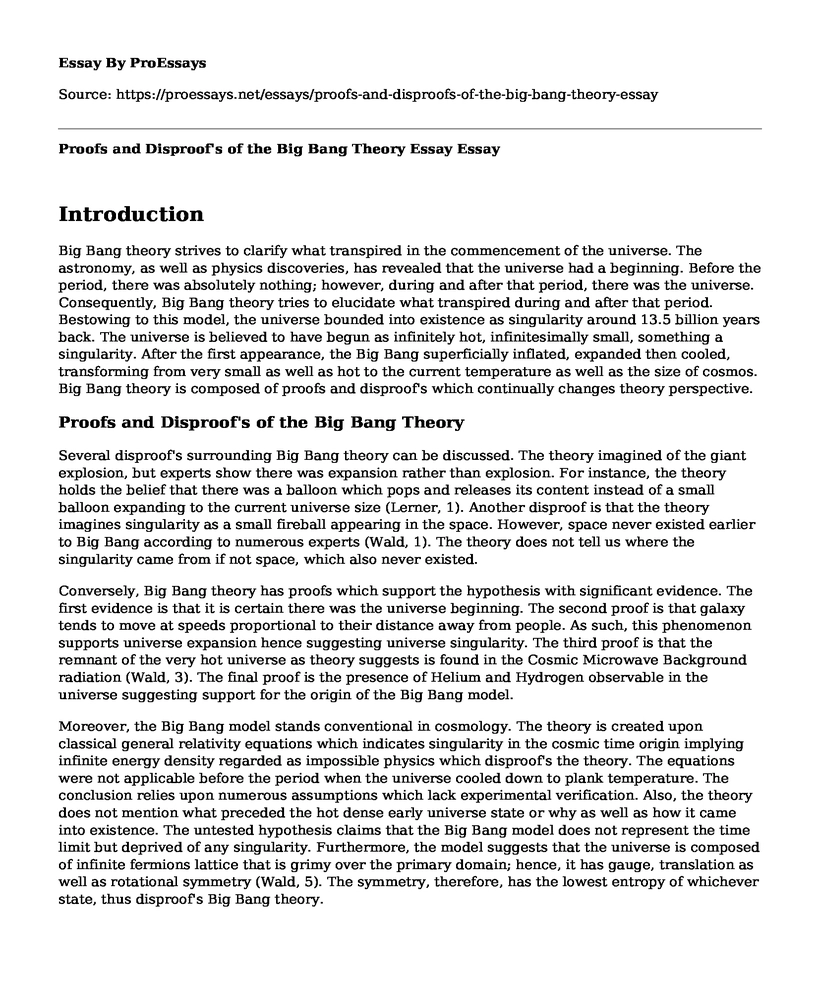Introduction
Big Bang theory strives to clarify what transpired in the commencement of the universe. The astronomy, as well as physics discoveries, has revealed that the universe had a beginning. Before the period, there was absolutely nothing; however, during and after that period, there was the universe. Consequently, Big Bang theory tries to elucidate what transpired during and after that period. Bestowing to this model, the universe bounded into existence as singularity around 13.5 billion years back. The universe is believed to have begun as infinitely hot, infinitesimally small, something a singularity. After the first appearance, the Big Bang superficially inflated, expanded then cooled, transforming from very small as well as hot to the current temperature as well as the size of cosmos. Big Bang theory is composed of proofs and disproof's which continually changes theory perspective.
Proofs and Disproof's of the Big Bang Theory
Several disproof's surrounding Big Bang theory can be discussed. The theory imagined of the giant explosion, but experts show there was expansion rather than explosion. For instance, the theory holds the belief that there was a balloon which pops and releases its content instead of a small balloon expanding to the current universe size (Lerner, 1). Another disproof is that the theory imagines singularity as a small fireball appearing in the space. However, space never existed earlier to Big Bang according to numerous experts (Wald, 1). The theory does not tell us where the singularity came from if not space, which also never existed.
Conversely, Big Bang theory has proofs which support the hypothesis with significant evidence. The first evidence is that it is certain there was the universe beginning. The second proof is that galaxy tends to move at speeds proportional to their distance away from people. As such, this phenomenon supports universe expansion hence suggesting universe singularity. The third proof is that the remnant of the very hot universe as theory suggests is found in the Cosmic Microwave Background radiation (Wald, 3). The final proof is the presence of Helium and Hydrogen observable in the universe suggesting support for the origin of the Big Bang model.
Moreover, the Big Bang model stands conventional in cosmology. The theory is created upon classical general relativity equations which indicates singularity in the cosmic time origin implying infinite energy density regarded as impossible physics which disproof's the theory. The equations were not applicable before the period when the universe cooled down to plank temperature. The conclusion relies upon numerous assumptions which lack experimental verification. Also, the theory does not mention what preceded the hot dense early universe state or why as well as how it came into existence. The untested hypothesis claims that the Big Bang model does not represent the time limit but deprived of any singularity. Furthermore, the model suggests that the universe is composed of infinite fermions lattice that is grimy over the primary domain; hence, it has gauge, translation as well as rotational symmetry (Wald, 5). The symmetry, therefore, has the lowest entropy of whichever state, thus disproof's Big Bang theory.Conclusion
In summary, Big Bang theory stands grounded on proofs and disproof's. The theory is grounded on a faulty paradigm, which is inconsistent with empirical data. For example, it cannot disapprove the Earth's center, which is spherically symmetrical with the universe. The proof of the theory is the presence of Helium as well as Hydrogen observable in the universe suggesting support for the origin of the Big Bang model. The galactic microwave background radiation discovery provides significant proof of Big Bang predictions by Gamow, Alpher, and Herman. Also, the surface of the latter scattering corresponds to the emission of CMB, which transpired shortly after recombination.
Works Cited
Lerner, Eric. The Big Bang never happened: a startling refutation of the dominant theory of the origin of the universe. Vintage, 2010.
Wald, Robert M. Space, time, and gravity: the theory of the big bang and black holes. University of Chicago Press, 1992.
Cite this page
Proofs and Disproof's of the Big Bang Theory Essay. (2022, Feb 21). Retrieved from https://proessays.net/essays/proofs-and-disproofs-of-the-big-bang-theory-essay
If you are the original author of this essay and no longer wish to have it published on the ProEssays website, please click below to request its removal:
- Personal Statement: Applying for Top Chemical Engineering Ph.D. Program
- Durban South Africa Paper Example
- Paper Example on Overcoming Math Anxiety: Cognitive, Affective & Working Memory Models
- Essay Sample on Real-Life Uses of Algebra: Shopping, Cooking & More
- Paper Example on Employee Exposure to Methyl n-Amyl Ketone: An Evaluation
- Paper Sample on Thomas Graham: Pioneer in Chemistry and the Father of Diffusion Studies
- Nucleotide Synthesis and Purification - Report Sample







